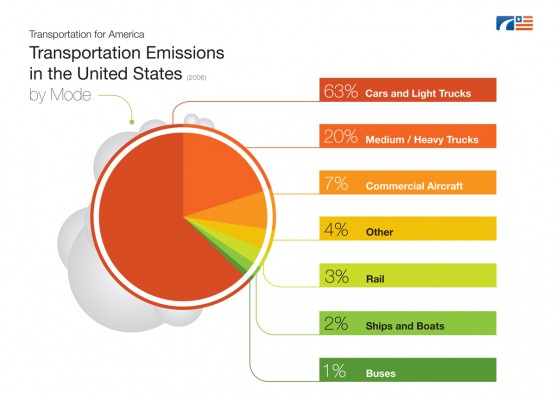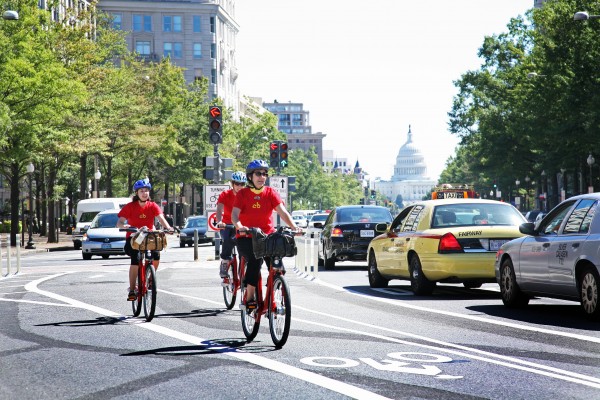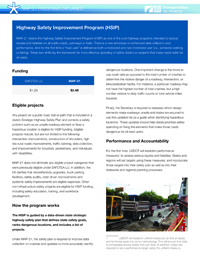Congestion Mitigation and Air Quality
The CMAQ program provides funding for projects that will relieve congestion and reduce pollution levels to help states and metro regions meet federal air quality standards. CMAQ funds may support many different types of projects. However, this program may not fund projects that lead to increased travel by single-occupant vehicles (SOVs). For instance, CMAQ funds may not support construction or expansion of general travel lanes. Instead, CMAQ funds are directed towards projects, programs, and operational strategies that provide residents with transportation options, make the most effective use of existing facilities, and lead to lower pollution levels.
Funding
SAFETEA-LU: $2.3 billion
MAP-21: $2.2 billion
MAP-21 made a significant change, allowing states to transfer up to 50 percent of CMAQ program funds into other programs for other uses. Under SAFETEA-LU, only 20 percent of CMAQ funds could be transferred to other programs. For this reason, it has become more important to communicate to local and state leaders the need to prioritize CMAQ dollars for congestion mitigation and air quality improvement projects.
Eligible projects
The following table presents some of the most common CMAQ project categories, though it is not an exhaustive list. Additional details are available through the CMAQ program guidance: www.fta.dot.gov/documents/cmaq08gd.pdf
- Establishment or operation of a traffic monitoring, management, and control facility
- Transit capital projects and improved transit services, including operational assistance for new or expanded service for up to 3 years
- Projects that improve traffic flow, including projects to improve signalization, construct HOV lanes, improve intersections, add turning lanes
- Bicycle and pedestrian facilities
- Diesel retrofits of older engines
- Variable roadway pricing
- Construction of facilities serving electric or natural gas-fueled vehicles
- Fringe and corridor parking facilities
- Projects that shift traffic demand to nonpeak hours or other transportation modes, increase vehicle occupancy rates, or otherwise reduce demand.
- Carpool and vanpool services
- Intelligent transportation systems (ITS)
- Intermodal freight capital projects
In addition, MAP-21 requires states and metropolitan regions that are labeled as “nonattainment” or “maintenance” areas for PM 2.5 (tiny particulate matter that results from the combustion of fuel) to spend a certain percentage of CMAQ funds on projects that will reduce this harmful pollution.
How the program works

In 1990, Congress enacted a series of amendments that strengthened the Clean Air Act. The following year, Congress passed ISTEA, the transportation law that first established the CMAQ program. After realizing the harmful by-products of all the new driving made possible by 40 years of investments in the Interstate system, CMAQ was created to provide states with flexible funding for projects that reduce congestion and improve air quality, along with meeting the more aggressive clean air standards of the amended Clean Air Act.
CMAQ funds are disbursed to and within a state based on levels of pollution within an area, and then the state or the region uses that money to implement projects that reduce congestion or improve air quality by investing in the types of eligible projects listed above.
Performance and Accountability
MAP-21 establishes several national goals, including to “enhance the performance of the transportation system while protecting the natural environment.”
Within 18 months, the Secretary of Transportation must establish a uniform standard for how states are to measure traffic congestion and transportation emissions. Then, states and metropolitan planning organizations serving regions with a population over 1 million must set performance targets for congestion and air quality. Presumably, these targets will reinforce ongoing efforts to meet Clean Air Act standards (also called National Ambient Air Quality Standards or NAAQS).
To meet those targets, metropolitan planning organizations representing over 1 million in population must develop a “performance plan” that includes a baseline measure of congestion and transportation emissions as well as a description of progress towards goals and projects to achieve those goals. These plans must be updated every 2 years.

Washington, DC used CMAQ funds (in part) to help launch Capital Bikeshare, providing a transportation option other than solo driving for short trips.






